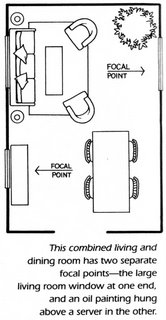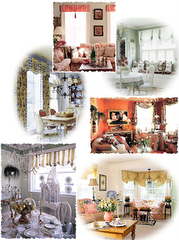
The Four Goals of a Conversation Area
1. To create a simple arrangement of furniture so that people can sit facing each other and can speak without raising their voices. Generally, the basic ingredients required to create the ideal conversation arrangement is a standard living room are a sofa, a piece of furniture serving as a coffee table (it can be an ottoman, for instance), and two upholstered chairs. There are alternatives, however, such as a pair of loveseats with a pair of chairs. But keep two things in mind: a) upholstered furniture is the more comfortable, and b) whatever the configuration, everyone seated should be able to reach the central coffee table. If space allows, a secondary privacy area can be set up, which might consist of a desk and a chair, or a club chair and ottoman with a table and lamp next to it. Very large rooms can even hold back-to-back sofas or love seats, creating two separate and distinct conversation areas with the addition of chairs.
2. To establish a focal point in the room. A wall unit, fireplace (a real on if you're lucky, or a fake one, if you can manage it), or even a grand piano can serve as the dominant fixture in the room, which helps orient the whole arrangement and gives you a visual reference point.
3. To eliminate traffic that runs through the conversation area (unless there is no alternative). In other words, the arrangement should be self-contained so that conversations will not be interrupted.
4. To free up space in the room for other functions, like a separate reading or working area. Once you establish a workable arrangement, the rest of the room begins to fall into place naturally-like finding the key piece in a complex jigsaw puzzle.
••••••••••••••••••••••••
Focal Points in Other Rooms
In rooms other than the living room, the focal point is more often defined by the use of the room. The bed in the bedroom or a wall in a study are the most obvious examples. One important exception is in the dining room, where the table or its decoration cannot serve as the room's centerpiece.
The Dining Room
The same guidelines that help establish the focal point in the living room apply to the dining room. Therefore, your dining table, with its central location, is automatically eliminated as a focal point. And it's not just placement that is a factor; even if your table is against a wall, it still won't qualify because there's nothing visually important on the wall. Remember, the focal point must dominate one wall. What will work? A buffet with a large painting, a grouping, or a framed mirror above it can work; an extremely large oil painting; or a mural alone on one wall. And of course, a fireplace with art hung above, a wall of sliding or French doors, or a large picture window will always dominate a room- any room-visually. If you choose to make your sideboard the focal point you can use two dining chairs to flank it and make it more important. If you have a combined living room and dining room-whether it's a shape or long rectangle-each area needs its own focal point.
The Bedroom
In the bedroom, the bed is almost always the focal point simply because of its size.With the bed placed against the longest wall, you will want to follow the same guidelines that we discussed earlier for creating and enhancing a focal point. If you don't have a headboard, you can create an attractive backdrop with a decorative or metal screen or panel behind the bed. If you have a simple headboard, you may want to hang a wide painting or a trio of frame prints above the bed. An elaborate headboard will serve as a focal point with no additional enhancement necessary. Matching end tables with lamps will make the bed seem wider, giving it additional prominence as the focal point. Many bedrooms do not have a long wall uninterrupted by doors and windows. You might consider positioning your bed in front of a double or a large picture window. This will create a more dramatic focal point, especially if there is a good view. Also, you can accentuate the appeal of the bed itself by using linens and accessories to their best advantage. Even if you have a large armoire or a dresser with a grand mirror, the bed and its headboard remain the only focal point with few exceptions, such as a wall of glass doors or windows that reveal a great view.
The Foyer
It can be dramatic or simple, fussy or serene-the focal point of your foyer has two jobs. It must attract you and welcome you. An ornately carved mirror above a bombe chest commands attention with its elegance. A large oil painting of a sunny seascape paired with a weathered pine bench please your eyes with their warmth. The image of an eye-catching framed black-and-white photo leaning on an ebony shelf in a tiny vestibule is difficult to ignore And just as a travel brochure is meant to draw the traveler to more exciting destinations, an alluring focal point will make whoever walks through the door eager to see more.
Your Focal Point Checklist
To make sure that you have found or created an effective focal point, consider the following:
Have you identified the largest, most dramatic element in your room?
Does your conversation area face the focal point or is it part of it?
Have you reinforced the focal point by placing other furnishings and accessories around it to balance and emphasize it?
Is the painting, mirror, or screen over or behind the sofa both large and dramatic enough to provide the impact you want?
If you are using a medium-sized armoire, bookcase, or wall unit as a focal point, are you using art or accessories on either side of it to make it look broader and more striking?
Can you use a cherished keepsake or antique piece to create the focal point?
Have you created a focal point for your dining room other than the table?
If you have a combined living and dining room, have you balanced the focal points for each room so that they are distinctive yet do not overpower one another?
Do accessories and art reinforce your bed as the focal point of the bedroom?
Do you have a piece of art or a mirror above a shelf or chest in your entrance?
Are you comfortable?


No comments:
Post a Comment